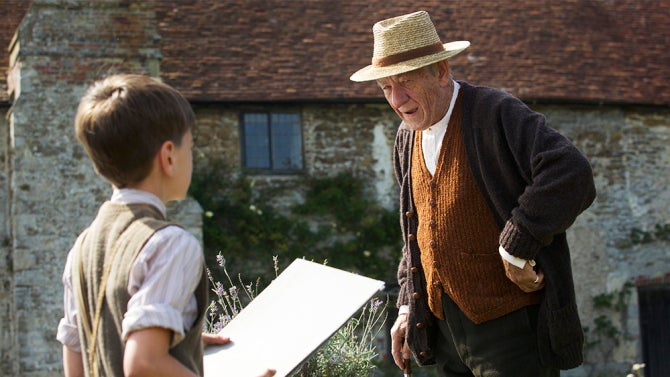The past decade has seen a new love for Sir Arthur Conan Doyle’s defining creation, the venerable detective Sherlock Holmes. Guy Ritchie’s Sherlock Holmes films and Mark Gatiss and Steven Moffat’s Sherlock series (as well as CBS’s Sherlock) have modernized the character through changes in tone and era, respectively. These updates have left many classic elements behind though. Mr. Holmes, director Bill Condon’s newest film, addresses the oldest parts of Doyle’s character, transforming their age into the thematic core of a new story. The result is a soft-spoken, clever, and surprisingly heart-filled film that ought to please fans of the great detective, both young and old.
Videos by ComicBook.com
Mr. Holmes, adapted from Mitch Cullin’s novel A Slight Trick of the Mind by Jeffrey Hatcher, follows a 93 year-old Sherlock Holmes living in seclusion with a housekeeper and her young son. Holmes is unable to walk without a cane and is slowly losing his memory; he spends his days attempting to recount his final investigation while tending to bee hives. The film moves between his current place to the recent past, when he traveled to post-WWII Japan seeking a cure for dementia, and the distant memories of his final investigation.
This parsing of time and memory results in a film that resembles its titular character. Like the hands of an elderly relative, it is soft to the touch and gentle in its actions. Yet there is a vigor and life beneath the surface that speaks to a keen mind and untold experiences. For all of its melancholy and methodical pacing, Mr. Holmes is filled with a passion that has not yet burned out. In this mood, both Holmes and his journey work together in order to create an enthralling story.
While the character at the heart of Mr. Holmes is unmistakable. There is a complex investigation, playful banter with a less clever sidekick, and lots of wordplay.The film’s conceit is something not found in Doyle’s stories, however. It focuses on both the difficulties of aging and the hard-earned wisdom that can only come through this process. While Holmes is still a figure of robust knowledge, his decline is clearly evidenced and its progress is painful. It is merely one more challenge that must be faced, and the quiet bravery shown is as empowering as anything found in superhero films this summer. Holmes discoveries relate as much to empathy and human connection, as they do to cold hard facts, but never in a maudlin manner.
That balance of adding humanity while retaining the character’s core is wonderfully struck by Sir Ian McKellen, a man whose legacy may already stand as tall as the character he portrays here. After watching McKellen on screen for two hours, it is impossible to imagine any other actor portraying the aged Holmes as well (especially now that his friend and renaissance man Sir Christopher Lee has passed). He is reserved, astute, and quietly funny. Character and change is revealed in very small flourishes, perfect for a character so disconnected from those around him. McKellen is Holmes, there is no doubt about that.
What may come as a greater surprise is how well Milo Parker as Roger Munro plays off of McKellen, Mr. Holmes being only his second film. Their friendship is clearly developed and it is a joy to see Roger, a bright young lad, flourish under Holmes’ odd mentorship. He is almost as well realized as Holmes with a rich inner life that plays out in a similarly subtle manner.
Mrs. Munro, played by Laura Linney, is denied a similar amount of screentime only interacting through confrontations with Holmes or Roger. Condon does an excellent job of still making her an understandable character. Munro often serves as an obstacle for Roger and Holmes’ exploits, but she is never out to be a villain. Instead, it is often easier to sympathize with Mrs. Munro than the child and man-child who seek to undermine her wishes. Linney does a beautiful job of balancing Munro’s exhaustion and weariness with the love for her son that drives every action.
Those current relationships are carefully woven into the mystery that haunts Holmes from his past. It is a penny dreadful riff that plays upon Watson’s best instincts with exciting characters, odd novelties, and perplexing motives right up until the moment when it is not. The subversion of a classic Holmes’ mystery makes it no less exciting though. All of the clues are there for both Holmes and viewers to discover the solution. This time though it lends a great deal of thematic significance to both Holmes’ personal journey and his relationship with the Munros in the modern day.
Not all of the story elements are as neatly woven together though. Holmes visit to Japan provides an interesting dynamic between himself and his beneficiary Umezaki, but the broader strokes fail to connect. It is only two years after the United States dropped atomic bombs on Hiroshima and Nagasaki, and Japan is still in the midst of recovering from WWII. Holmes is confronted by various states of death and misery, most significantly at Hiroshima where he sees burned survivors and the ash-laden area where the bomb was dropped. These moments are made to feel significant, but add little value to Holmes’ personal arc or the film’s themes. It strives for too grand of a picture in a very personal story.
Rather than providing the full majesty of the country Holmes is visiting, all of these scenes feel claustrophobic. They are contained largely to interior shots with limited details, quickly assembled on a soundstage. When Holmes and Umezaki visit Hiroshima the use of computer generated elements (including the Atomic Bomb Dome) are haphazardly juxtaposed against real elements resulting in the film’s only notable cinematographic failing.
When the camera is placed in England, specifically along her Southern Coast, it oscillates between being serene and uniquely beautiful. From the lush green hills that surround Holmes’ cottage to the rocky, seaside cliffs Condon and cinematographer Tobias A. Schliessler allows the camera to take its time soaking in the scenery. This perspective provides additional value to Mr. Holmes‘ methodical nature, as well as reinforcing its mood and pace.
Mr. Holmes is unlike any new story about this iconic character found in the past 10 or 20 years. Condon avoids the pitfalls of modernization by embracing the character with all of his flaws and age, and then plumbing those elements for a new take. The result is both a striking new Holmes mystery and a reverie on aging and the importance of connection. It is a quiet, alluring film with a great deal of passion rest beneath that serene-looking exterior.
Grade: B









